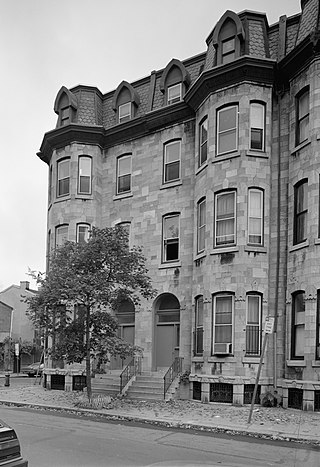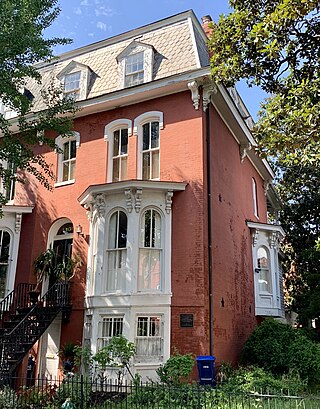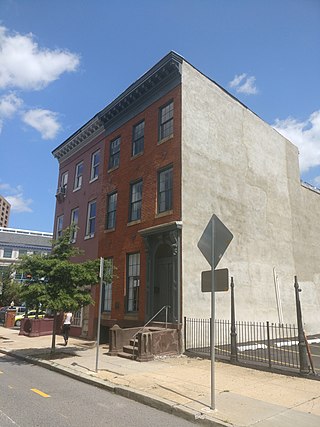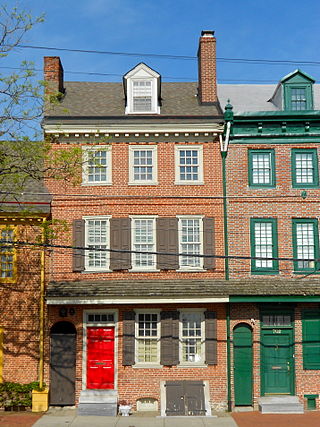
Henry Ossawa Tanner was an American artist who spent much of his career in France. He became the first African-American painter to gain international acclaim. Tanner moved to Paris, France, in 1891 to study at the Académie Julian and gained acclaim in French artistic circles. His painting Daniel in the Lions' Den was accepted into the 1896 Salon, the official art exhibition of the Académie des Beaux-Arts in Paris. Tanner's Resurrection of Lazarus was purchased by the French government after winning the third-place medal at the 1897 Salon. In 1923, the French government elected Tanner chevalier of the Legion of Honor.

The Mexican War Streets, originally known as the "Buena Vista Tract," is an historic district that is located in the Central Northside neighborhood of Pittsburgh, Pennsylvania, in the United States. The district is densely filled with restored row houses, community gardens, and tree-lined streets and alleyways. The area dates to around the time of the Mexican–American War.

Carpenters' Hall is the official birthplace of the Commonwealth of Pennsylvania and a key meeting place in the early history of the United States. Carpenters' Hall is located in Independence National Historical Park in Philadelphia, Pennsylvania.

Samuel Sloan was a Philadelphia-based architect and best-selling author of architecture books in the mid-19th century. He specialized in Italianate villas and country houses, churches, and institutional buildings. His most famous building—the octagonal mansion "Longwood" in Natchez, Mississippi—is unfinished; construction was abandoned during the American Civil War.

The Thomas Eakins House is a historic house at 1727-29 Mount Vernon Street in the Spring Garden section of Philadelphia, Pennsylvania, USA. Built about 1854, it was for most of his life the home of Thomas Eakins (1844-1916), one of the most influential American artist of the late 19th century. It was designated a National Historic Landmark in 1965, and is now home to a local artist cooperative.

The Henry Antes House is a historic house museum in Upper Frederick Township Montgomery County, Pennsylvania. Built in 1736 by Henry Antes, it is a particularly high-quality example of a Moravian settlement house, with intact original interior finishes. It was designated a National Historic Landmark in 1992, and is now operated as a museum by Goschenhoppen Historians, a local preservation group.

Wharton Esherick Studio, now housing the Wharton Esherick Museum, was the studio of the craftsman-artist Wharton Esherick (1887–1970), in Malvern, Pennsylvania. The studio was built between 1926 and 1966, reflecting Esherick's evolving sculptural style—from Arts and Crafts, through German Expressionism, ending with the free form Modernist curves that marked his later work.

Summerseat, also known as the George Clymer House and Thomas Barclay House, is a historic house museum at Hillcrest and Legion Avenues in Morrisville, Bucks County, Pennsylvania. Built about 1770, it is the only house known to have been owned by two signers of the United States Declaration of Independence, Founding Fathers George Clymer and Robert Morris, and as a headquarters of General George Washington during the American Revolutionary War. The house is now managed by the Morrisville Historical Society, which offers tours. It was designated a National Historic Landmark in 1965.

The John Coltrane House is a historic house at 1511 North 33rd Street in Philadelphia, Pennsylvania, USA. A National Historic Landmark, it was the home of American saxophonist and jazz pioneer John Coltrane from 1952 until 1958. On his death in 1967 the house passed to his cousin, who sold it in 2004. Efforts for restoration and reuse as a jazz venue are struggling. In 2022, two of Coltrane's sons filed a lawsuit contesting the ownership of the home.

The Edward Drinker Cope House is a historic house located at 2100–2102 Pine Street in Center City Philadelphia, Pennsylvania. Built in 1880, it was a longtime home of Edward Drinker Cope (1840–1897), a prolific geologist and paleontologist and noted herpetologist who was one of the leading natural scientists of the 19th century United States. It was declared a National Historic Landmark in 1975.

The Frances Ellen Watkins Harper House is a historic row house at 1006 Bainbridge Street in Philadelphia, Pennsylvania, USA. Of uncertain construction date, it was the home of Frances Ellen Watkins Harper (1825-1911) from 1870 until her death. Harper was a prominent African-American abolitionist, women's rights and civil rights activist, and author. It was designated a National Historic Landmark in 1976.

The Hill–Physick–Keith House, also known as the Hill–Keith–Physick House, the Hill–Physick House, or simply the Physick House, is a historic house museum located at 321 S. 4th Street in the Society Hill neighborhood of Philadelphia, Pennsylvania, USA. Built 1786, it was the home of Philip Syng Physick (1768–1837), who has been called "the father of American surgery". The house was declared a National Historic Landmark in 1976. It is now owned and operated by the Philadelphia Society for the Preservation of Landmarks as a house museum.

The New Century Guild, now the New Century Trust, is an historic women's support organization which is headquartered in Philadelphia, Pennsylvania. Founded in 1882, it is one of the oldest and largest organizations devoted to meeting the needs of women in the labor force.

The Reynolds-Morris House is an historic house which is located at 225 South 8th Street in the Washington Square West neighborhood of Philadelphia, Pennsylvania. Built between 1786 and 1787 by John and William Reynolds, it is a well-preserved example of a Philadelphia Georgian townhouse.

The Thomas Sully Residence is a historic rowhouse at 530 Spruce Street in Philadelphia, Pennsylvania, USA. It was briefly (1828–29) a home of painter Thomas Sully (1783-1872), who lived in Philadelphia for the last 64 years of his life.

The Zalmon Richards House is a historic house in Washington, D.C. A Second Empire rowhouse, it was home from 1882 until his death of Zalmon Richards (1811–1899), founder of the National Education Association. It was declared a National Historic Landmark in 1965. It is a private residence.

The Henry AugustRowland House is a historic row house at 915 Cathedral Street in Baltimore, Maryland. Built in the 1880s, this nondescript row house is historically important as the home of physicist Henry Augustus Rowland from 1889-90 until his death in 1901. It was listed on the National Register of Historic Places and declared a National Historic Landmark in 1975.

The Henry George Birthplace is an historic home which is located in the Washington Square West neighborhood of Philadelphia, Pennsylvania.

The Nathaniel Irish House is an historic, American home that is located in the Queen Village neighborhood of Philadelphia, Pennsylvania.

Sarah Elizabeth Tanner was active as a missionary worker and a religious leader in the African Methodist Episcopal Church.

























